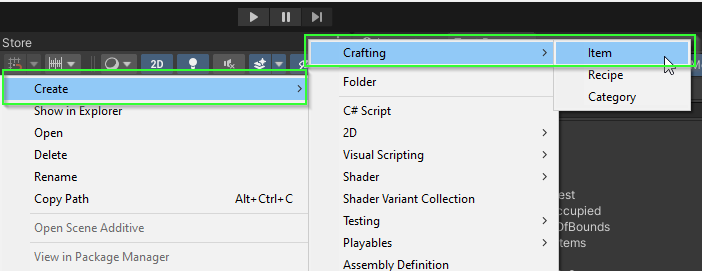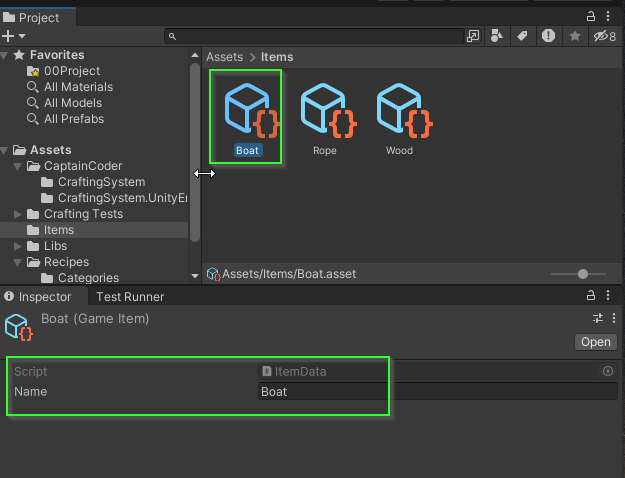Day 3: Scriptable Objects and Recipe Database
Today, we finished a basic implementation of the CraftingContainer. Additionally, we took our first dive into ScriptableObjects by defining scriptable object types for items, recipes, and recipe categories! Lastly, we started work on an implementation of the `RecipeDatabase class.
Table of contents
Completing CraftingContainer
The first order of business was to finish writing tests and implementing the CraftingContainer class from Day 2. This went quite smooth. The only “tricky” code was the TryMove method below. I personally feel the method is a little difficult to read and understand. It is designed to allow two positions within the container to be swapped. It returns true if the state of the container has changed after calling it and false otherwise.
public bool TryMove(Position from, Position to)
{
// At least ONE position must have something
if (!_grid.ContainsKey(from) && !_grid.ContainsKey(to)) { return false; }
// If both spots are occupied, swap them
if (_grid.ContainsKey(from) && _grid.ContainsKey(to))
{
(_grid[to], _grid[from]) = (_grid[from], _grid[to]);
}
else if (_grid.ContainsKey(from))
{
// If just from is occupied, move it.
_grid[to] = _grid[from];
_grid.Remove(from);
}
else
{
// If just to is occupied, move it.
_grid[from] = _grid[to];
_grid.Remove(to);
}
return true;
}
- The
CraftingContainersource from Day 3 is available here: LINK - The
CraftingContainerTestsource from Day 3 is available here: LINK
Scriptable Objects
Unity’s Documentation: A ScriptableObject is a data container that you can use to save large amounts of data, independent of class instances. One of the main use cases for ScriptableObjects is to reduce your Project’s memory usage by avoiding copies of values. This is useful if your Project has a Prefab that stores unchanging data in attached MonoBehaviour scripts.
ItemData
After completing the CraftingContainer class, I wanted to see how I might be able to use the ShapelessRecipe class within a Unity project. I started by adding an assembly specifically for the portions of the code that would rely on UnityEngine libraries.
Within the assembly, I created my first ScriptableObject which will be an implementation of the IItem interface specified within CaptainCoder.CraftingSystem:
[System.Serializable]
[CreateAssetMenu(fileName = "Item", menuName = "Crafting/Item", order = 0)]
public class ItemData : ScriptableObject, IItem
{
[field: SerializeField]
private string Name { get; private set; }
}
-
We chose to use the convention that all ScriptableObject implementations will end with the name
Dataand thus the class is namedItemData. -
The
CreateAssetMenuattribute allow us to create instances of theGameItemusing the Unity menu in the Project Explorer.

- Additionally, because we specified the
[field: SerializeField]attribute on theNameproperty, we can modify it in the Inspector.

CraftingCategoryData
Additionally, we created a wrapper ScriptableObject for CraftingCategory: CraftingCategoryData:
[CreateAssetMenu(fileName = "CraftingCategory", menuName = "Crafting/Category", order = 2)]
public class CraftingCategoryData : ScriptableObject
{
[field: SerializeField]
public string Name { get; private set; }
public CraftingCategory AsStruct => new (Name);
}
Because CraftingCategory is not an interface, the CraftingCategoryData I added a method AsStruct which converts the CraftingCategoryData into a CraftingCategory. It might make sense to write a ICraftingCategory interface instead. Doing so would be more modular and consistent with how IItem works.
ShapelessRecipeData
Next, it was time to create a ScriptableObject which has enough information to create a ShapelessRecipe. Recall that the ShapelessRecipe requires 3 components: a list of ingredients, a CraftingCategory and a list of resulting items. Additionally, the ShapelessRecipe class uses a generic type: ShapelessRecipe<T> where T : IItem. This was intentional to allow for the T type to be Serializeable using Unity’s serialization tools.
A generic ShapelessRecipeData<T> was written to mimic the ShapelessRecipe class:
public class ShapelessRecipeData<T> : ScriptableObject where T : IItem
{
[field: SerializeField]
public List<T> Ingredients { get; private set; }
[field: SerializeField]
public CraftingCategoryData Category { get; private set; }
[field: SerializeField]
public List<T> Results { get; private set; }
public ShapelessRecipe<T> AsRecipe => new (Ingredients, Category.AsStruct, Results);
}
Once again, it might make more sense to have an IShapelessRecipe<T> interface rather than providing an AsRecipe method.
Because the ShapelessRecipeData<T> is generic, it isn’t possible to edit them in the inspector. Thus, I did not include a CreateAssetMenu attribute.
Lastly, I extended the ShapelessRecipeData class specifying I would like to use ItemData as my concrete IItem type:
[CreateAssetMenu(fileName = "Recipe", menuName = "Crafting/Recipe", order = 1)]
public class GameRecipeData : ShapelessRecipeData<ItemData> {}
By specifying the concrete type as a Serializable type, we can create and edit GameRecipeDatas directly in the inspector.
LEARNING GOAL #1 ACHIEVED
Learning Goal #1: Learn about Scriptable Objects!
RecipeDatabase
With just a small amount of time left at the end of the coding session, I attempted to implement a RecipeDatabase class. The goal of this class is to allow quick lookup of a recipe given ingredients and a CraftingCategory. I defined the following API:
public class RecipeDatabase<T> where T : IItem
{
/// <summary>
/// Retrieves the recipe associated with the specified set of ingredients and category. If one is found, the recipe
/// value is set and the method returns true. Otherwise, the value of recipe is undefined and the method returns false.
/// </summary>
public bool TryGetRecipe(IEnumerable<T> ingredients, CraftingCategory category, out ShapelessRecipe<T> recipe);
}
I’m not yet sure how a RecipeDatabase will be constructed BUT I know for sure that I should not need to iterate through all possible recipes to find the matching ShapelessRecipe. Additionally, the order of the specified ingredients should not matter. For example, a “wood, wood, rope” should produce the same recipe as “rope, wood, wood” or “wood, rope, wood”.
To accomplish this, I began implementing a RecipeEntry class:
public class RecipeEntry
{
private readonly Dictionary<T, int> _itemCounts = new();
private readonly CraftingCategory _category;
private readonly int _hashCode;
public RecipeEntry(IEnumerable<T> ingredients, CraftingCategory category);
public override bool Equals(object obj);
public override int GetHashCode() => _hashCode;
}
The idea with the RecipeEntry is to use it as a key in a Dictionary<RecipeEntry, ShapelessRecipe>.
To ensure the GetHashCode() returns the proper key regardless of the order of ingredients, I initialize it by summing the hash codes of each ingredient and combine that value with the hash code of the category:
public RecipeEntry(IEnumerable<T> ingredients, CraftingCategory category)
{
_hashCode = 0;
foreach(T item in ingredients)
{
_hashCode += item.GetHashCode();
}
_category = category;
_hashCode = HashCode.Combine(_hashCode, _category);
}
This should be enough to ensure that the keys match within a dictionary.
Next, we needed to override the Equals method to ensure the order doesn’t matter. To do this, I use the Dictionary<T, int> _itemCounts; field to track the count of each type of ingredient. Two RecipeEntry’s will be equal if their hash codes match, they have the same category, and the key/value sets of _itemCounts match. Unfortunately, we didn’t quite have enough time to finish this implementation.
We made a great amount of progress today! But, with only 4 days left… is there enough time to finish the first version of this system? Only time will tell!
Join the Discussion
Before commenting, you will need to authorize giscus. Alternatively, you can add a comment directly on the GitHub Discussion Board.